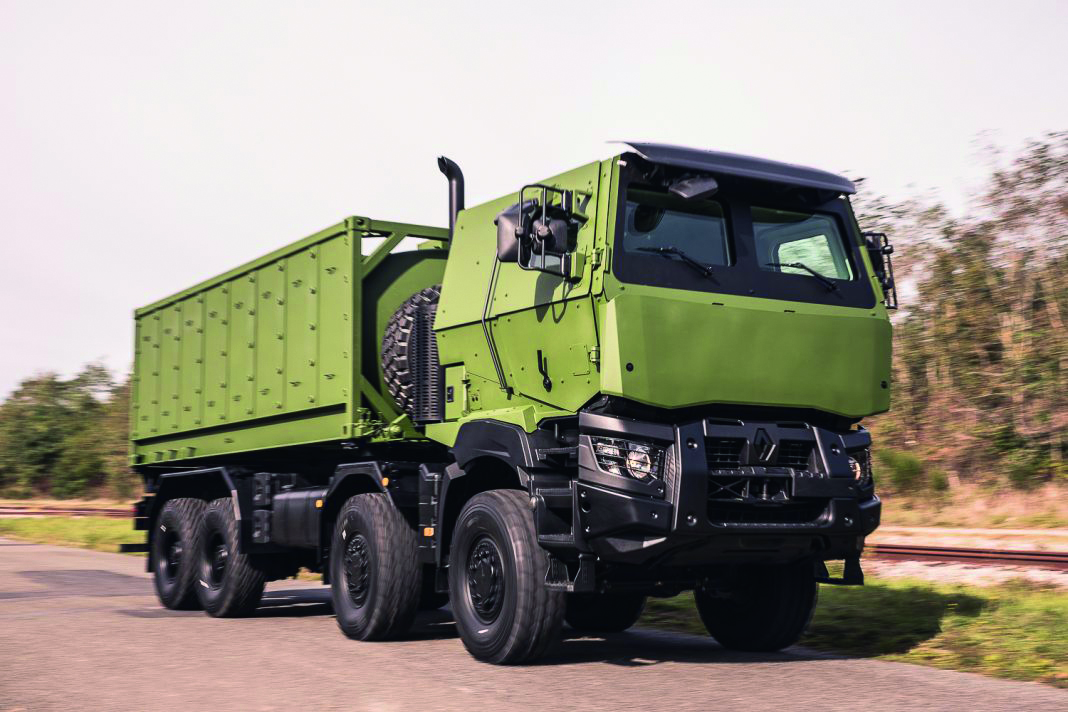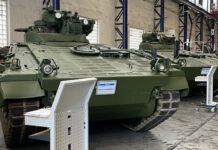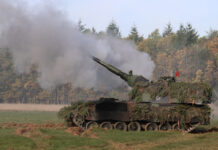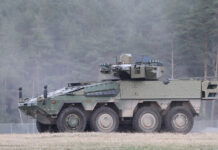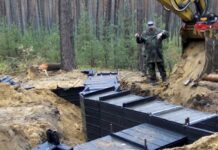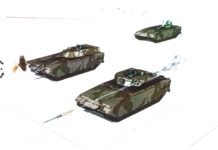In modern combat, often characterised by operations covering extensive areas, it is logistics – based on efficient trucks – that is one of the guarantees of successful action. Military trucks are benefiting from the ongoing development of civilian trucks, but they also require special features.
Reliability, high transport performance, tactical mobility and, last but not least, adequate protection, are among the key requirements for military logistics trucks. The planned lifespan of ten to twenty years, often exceeded in practice, requires high growth potential.
The German Government’s current economic stimulus package offers the Bundeswehr the opportunity to use additional funds to significantly accelerate the modernisation of its truck fleet; up to €10Bn having been made available in the package.
Vehicle Categories
The military demand for trucks is low compared to the output levels of large factories. Therefore, the standards and development levels applied in the civilian sector represent the starting point when vehicle specifications and requirements for military vehicles are in question.

Military logistics trucks can be divided into three categories depending on their intended use and any adaptations required.
If only minor adaptations are required, commercial (handelsüblich, hü) trucks are used by the military in the same way as they are offered on the civilian market. The range of requirements will often include high mileage on well-developed supply routes, but protection against ballistic or blast threats are not considered necessary specifications for these vehicles. Consequently, the procurement and operation of these vehicles are particularly cost-effective.
Vehicles requiring extensive adaptation for military requirements can be categorised as being commercially available, but with special military equipment included in their specifications (handelsüblich mit militärischer Sonderausstattung, hümS). This can include mountings for military equipment such as weapons and for communications, as well as more robust and raised underbodies in order to increase their suitability for off-road driving. Overall, however, this category of vehicle design remains untouched and the vehicles are approved for public road use without any restrictions.
The third category is militarised vehicles, which are designed and built from scratch in order to meet military requirements. In their production, manufacturers use largely tested parts and assemblies and components from large-scale production. This approach avoids any development risks, increases reliability and reduces manufacturing costs. Protection of crews from threats on the battlefield and armament are among the options frequently implemented in this category of vehicles.
Framework of Military Requirements
In addition to technical advances in vehicles offered on the civilian truck market, the requirement for military specifications provide impetus in the further development of military logistics trucks. High efficiency and adequate protection levels are the guiding features according to which modern trucks are developed for the armed forces.
In Germany, the MoD identifies four areas in which the design of logistics vehicles is determined:
- Fuel resilience: NATO requirements such as the single fuel policy are critical. On the other hand, the vehicles should comply with public road traffic regulations as far as possible. For example, they should be able to be operated without an exemption permit. This is dealt with in the section “Drivetrain”.
- Protection: Soldiers must be given the best possible protection. In the case of trucks, the level of protection mainly relates to the cabin space. Depending on the various deployment scenarios (such as international crisis management or national and Alliance defence), protection requirements are graded. This can be seen, among other things, in the equipment of some trucks with protected cabins and the possibility of arming them, including with remotely controlled weapon stations. The subject of “Protection” will be addressed again later.
- Automation: The use of automation (automatically operated) is required in order to relieve the burden on drivers when operating vehicles. Unmanned driving, as the highest level of automation, also serves, among other things, to protect the soldiers, but is not yet sufficiently controllable from a technical point of view. Individual aspects are described in the section “Operation”.
- Separation of mobility and functionality: The three areas mentioned so far are rather technical in nature. The functional requirements include the separation of mobility and functionality. In this regard, the truck becomes a carrier of functional platforms. As a universal means of transport, he truck can be engaged in other tasks once the functional platform has been unloaded and can be temporarily employed as a stationary unit. As a functional platform, interchangeable loading systems, conventional flatbeds, general cargo containers or standard size containers, are used with equipment and/or workstations in the execution of tasks.

Basics
As mentioned, the production volume of military trucks is low compared to supply in the civilian market. For this reason, the technical development of the large-series trucks and the experience gained from commercially operated vehicles dictate the design framework for new military trucks. Technical innovations and improvements are continuously being introduced as part of model upgrades, meaning new models, but at longer time intervals.
In contrast, military vehicles are procured with a planned service life of up to twenty years, are often in service for even longer and do not come close to reaching the mileage levels of their civilian counterparts.
Truck manufacturers have special development branches dedicated for the design of military trucks. They use modular construction kits with components and units that have proven their worth in service and can therefore build trucks that meet military requirements. Modularisation and standardisation have a positive effect on the broad applicability and also on logistical simplification.
Chassis
The chassis is literally the supporting frame of the vehicle. The core is made up of C-profiles of high-strength, high-performance fine-grain steel, which are bolted together with cross girders to form a low-torsion ladder frame. The profiles are painted with rust-protective paint before processing, which guarantees the frame’s durability. Design guidelines require several hundred thousand kilometres with a high off-road proportion.
The electrical, hydraulic and pneumatic data and power supply lines are laid on the inside of the C-profiles, protected from wood and stones when driving on challenging terrain, as well as from bullets, splinters and from explosive blasts. In most series, the frame is the same for all variants, except for the length. Occasionally, a reinforcing material is added. At the front of the vehicle, the cab, engine and other units put load on the front axle(s), so the frame is reinforced for the optional protected cab (additional load of around two tonnes).
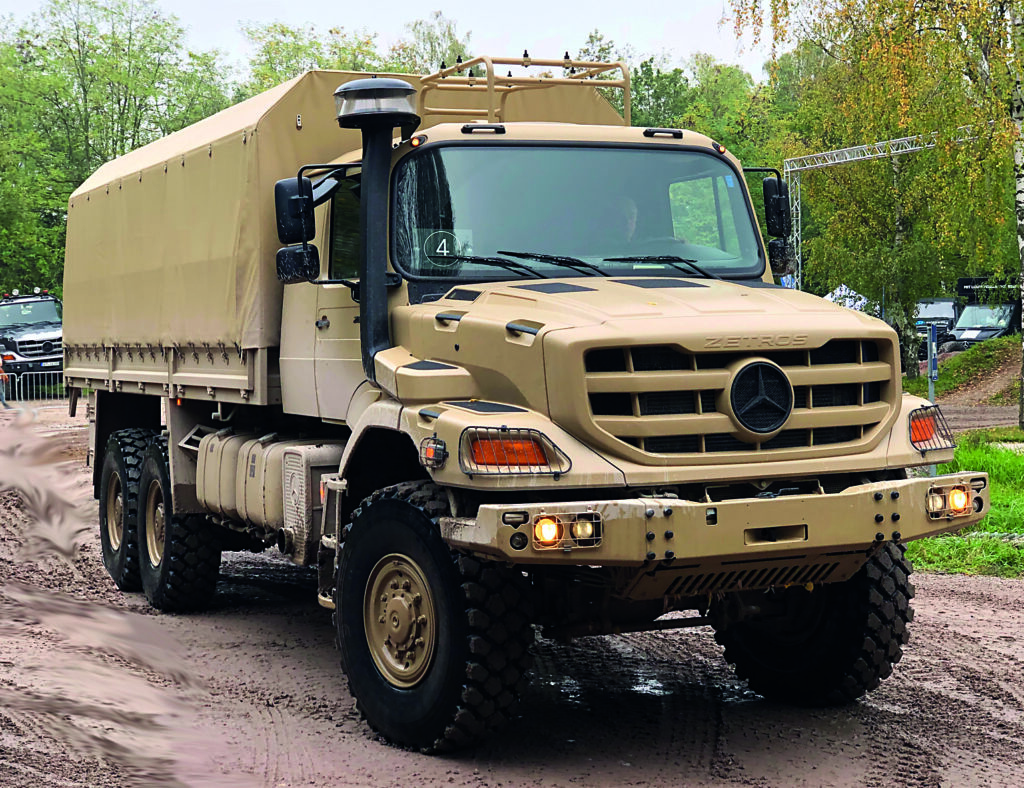
The frame absorbs the torsion that occurs during off-road driving and provides the connection points for the rigid load carriers such as flatbeds, swap bodies or containers via torsion-free, height and weight optimised intermediate frames.
Containers are currently becoming a standard load and are used, inter alia, for transporting supplies or for providing different mobile functions.
Interchangeable loading systems are optimised for the quick change of load carriers and do not require external equipment for this task. The interchangeable load carriers (racks) or containers, are loaded or unloaded using a hook system. Automated loading systems, such as the automated load handling system (ALHS), which the Australian company Supashock presented with Rheinmetall at the HX2, can halve loading times in the field, regardless of dirt and inaccurate alignment. ALHS can be operated by one person from the protection of the cabin.
Fixed superstructures are rare on new vehicles and are found mainly on heavy special-purpose vehicles. Competing with tracked vehicles in the area of special-purpose platforms, the entire vehicle is designed to carry out a special role; current examples include 155 mm howitzers, battlefield bridges or fire control or surveillance radars, which all use the logistical advantage of a uniform base vehicle.
Modern Cabin Equipment
The cabin is the control centre and living space at the same time. The cockpit corresponds as far as possible to the civilian version, supplemented by controls needed in a military setting, such as light management. Intuitive, user-friendly, operations, in accordance with civilian standards, allows even novice drivers to master the vehicle safely.
Swing seats that can be used with protective clothing allow for longer driver endurance times, as does the provision of air conditioning with an optimised airflow and integrated protective ventilation.
It is essential to provide the infrastructure for communication, reconnaissance, armament and electronic countermeasures. This includes electrical/electronic and mechanical interfaces, including vibration-protected racks for housing this equipment. In order to be able to install the often required armament, the cabin roof is prepared to accommodate mountings or remotely controlled weapon systems.
Drivetrain
Military logistics vehicles are powered by diesel engines as alternative power systems are not expected in the foreseeable future. These robust drive units are being further developed, especially with regard to fuel consumption and emission reduction. The exhaust emission standards applicable in Europe set maximum limits for carbon monoxide, particulate matter and nitrogen oxides. The currently valid Euro VI Step D standard requires fuels of a high quality that is often not achieved outside Europe. Euro V is therefore the standard requirement in many countries.
If logistics vehicles are equipped with Euro VI engines, measures must be taken to enable a mixed operation. Depending on the method of exhaust gas purification, components of the exhaust system, in particular the catalytic converter, must be replaced or rendered inoperable before and after operation with fuels of low quality, such as those used under NATO’s single fuel concept. Conversion kits have been developed for this purpose and are kept readily available by the armed forces. Conversion by maintenance personnel takes several hours but results in non-certified exhaust operation.
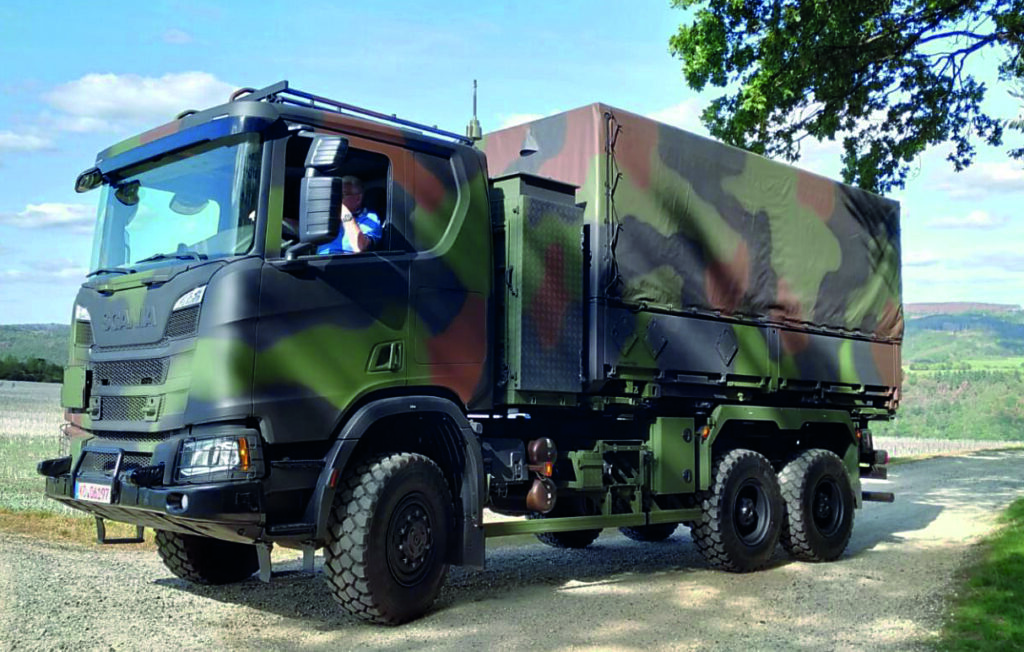
The power output of the engines ranges from about 175 kW to almost 400 kW with torques between 1,000 and 2,500 Nm.
Automated manual transmissions are standard. The Bundeswehr and some other armed forces use fully automatic transmissions which allow propulsion without interruption of tractive power. This is particularly advantageous when operating in difficult terrain, where the driver is fully occupied with navigating the route. A torque converter clutch supports sensitive starting under heavy load. Coupled with a retarder, as in the turbo retarder clutch offered by Daimler and Rheinmetall in their trucks, for example, starting off can be ensured even in difficult off-road situations.
Running Gear
Two to four – rarely five or more – axles transfer the vehicle weight, including payloads and the driving, guiding and braking forces to the ground via off-road tyres. Usually all axles are driven. Some tractors have non-driven rear axles.
Regarding the front axle, the focus of development is currently on an 11-tonne axle which will become the standard. One reason for this is possible high load due to the increased weight of the protected cab. High wheel loads lead to high steering resistance, which may require special steering gears. For the other axles, the axle load is between 10 and 16 tonnes. A steered rear axle on four-axle vehicles may reduce the turning circle and improve manoeuvrability.
Differential gears are integrated in the axles to compensate for the different wheel speeds when cornering. Self-locking differentials prevent the complete loss of tractive power at one wheel when the ground conditions at both wheels are very different. On off-road vehicles, the differentials can be locked if necessary. Longitudinal differentials are used to distribute the tractive force to the various axles.
Leaf springs are mainly used as springs for vibration isolation in military off-road vehicles.
Leaf springs are not effected by damage or dirt, but tend to weaken the suspension at small load changes due to friction. In conjunction with shock absorbers, they enable the necessary large wheel movements in off-road terrain and maintain the ground pressure forces required for tracking and steering.

In some cases, (including the German Army’s protected transport vehicles in the 15-tonne payload class), electronically controlled air suspension (ECAS) is also used to improve traction by shifting the load. In addition, the frame height can be adjusted independently of speed, load and road conditions, while maintaining a high level of ride comfort.
For specialised roles such as the above-mentioned radar carriers, battlefield bridging vehicles or howitzers, adjustable spring/damper combinations are used, such as those realised with active suspension systems. With active suspension, the forces exerted by the ground are used to change the spring characteristic curve and the damper properties in such a way that body movements are greatly reduced and specifically influenced. Hydro pneumatic spring elements controlled by sensors are particularly suitable for this purpose.
Protection
Due to the change in operating conditions, the protection of the crew has become a major priority. Protected cabins are a standard feature of new vehicles. Protected cabins are made of armoured steel and are designed to resist bullets, splinters and effects from blasts. This includes bulletproof windows, decoupling of seats and pedals from the floor and securing equipment attached to the floor.
The heavy weight and high price of the protected cabins has led to the concept of interchangeable cabins, which has not seen much use until now. In this regard, the chassis is prepared for high loads.
Active protection, in which effectors prevent, or at least greatly reduce the blast effect from shelling, can be integrated into the cabin. At Eurosatory 2018, Rheinmetall presented a demonstrator featuring the Active Defence System (ADS). However, active protection is rarely required for wheeled logistic vehicles.
In current procurement projects, around one-third to half of all vehicles are equipped with protected cabs. Unprotected cabins are often prepared to accommodate protective elements (such as on the unprotected transport vehicles currently being supplied to the Bundeswehr). This allows scalable protection to be provided. In Great Britain, for example, up to 95 % of tactical trucks can be equipped with add-on protection.
Protection against NBC warfare agents is ensured in conjunction with air conditioning/room cooling systems. On the one hand, all door, window and other openings are sealed. On the other hand, the breathable air is filtered and supplied via the air conditioning system. This creates an overpressure which creates a constant flow of air to the outside.
Vehicle Electronics
The electrical/electronic equipment of modern trucks is the biggest difference to the predecessor models and at the same time the area with the most dynamic development.
The market for commercial trucks leads the way here to a certain extent, but not every innovation offered for civilian applications can be applied to military vehicles. Commercial trucks, for example, are virtually always online with Bluetooth, WLAN, other short-range radio services, radar and mobile radio. In military vehicles, however, it is imperative to be able to create the “communications silence” state in which all radio devices can be switched off.
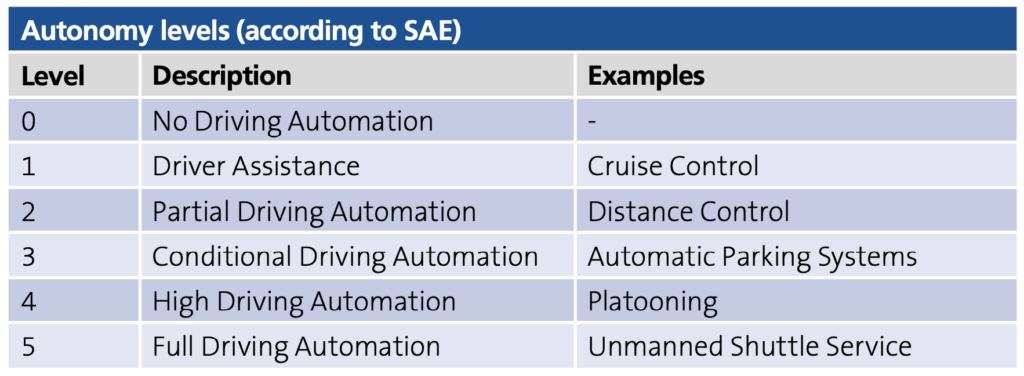 In STANAG 4754, NATO has defined specifications for the NATO generic vehicle architecture (NGVA), against which the design of new vehicles is measured. Characteristics are the networking of the subsystems via a common data bus and control via multifunctional operating and display units.
In STANAG 4754, NATO has defined specifications for the NATO generic vehicle architecture (NGVA), against which the design of new vehicles is measured. Characteristics are the networking of the subsystems via a common data bus and control via multifunctional operating and display units.
This results in several advantages. It is not just the devices that can be controlled via the well-protected data bus. Furthermore, the states of the subsystems are available everywhere for control and monitoring purposes. The cabling effort is reduced, the flexibility for integrating new devices increases and the effort for electromagnetic protection decreases. The cabling for the energy supply system can be separated from the data lines.
This results in short cables with a corresponding weight advantage.
The increasing number of electronic devices places high demands on the electrical power supply. The current on-board voltage of 24 V is not expected to change. With a higher voltage (such as 48 V), the required current of the devices will decrease and thus the necessary cable cross-section and weight for the cabling will decrease. High-performance generators supply 120 A to 180 A. As an option, 340 A to 400 A are also available, which is up to 9.6 kW at 24 V. Lithium-ion accumulators with capacities of more than 110 ampere hours (equivalent to 2.6 kWh) are being considered as energy storage devices. Their characteristics include a high peak current, e.g. for the starting process, and a high continuous current for the constant supply of the electronic devices even when the engine is not running. This also enables the energy supply of external consumers, for example, in the body.
The new batteries weigh only a quarter of the weight of lead batteries of various types. The disadvantages are a loss of performance at low temperatures and additional dangers in the event of fire.
Due to the extensive digitalisation of the devices and vehicle units, interfaces for controlling the devices are available. These interfaces can be accessed to set different mission modes (such as blackout camouflage mode) and to implement autonomous functions.
Operation
When operating the truck, the crew should concentrate on choosing the optimum route and speed depending on the terrain and (hostile) environment. Driver assistance systems are available for all other functions.
Traction control on off-road terrain is particularly difficult because practically every wheel has different conditions, which can also change quickly. Electronic drive train management, Automatic Traction Control (ATC) or Automatic Drivetrain Management (ADM) controls the differential locks on all axles, thus optimising the distribution of traction to improve mobility. ATC, developed by Volvo and offered by Arquus in the latest generation of its trucks, also reduces fuel consumption and tyre wear without driver intervention, reducing maintenance requirements and thus the logistical footprint. The ADM, as used by Iveco in military off-road vehicles, for example, controls all differentials depending on wheel slip in order to achieve the highest possible traction at all times.
With anticipatory driving, terrain utilisation can be greatly improved. Based on current maps and including location-based presentation of other information sources (such as aerial and satellite images, gradient maps, contour lines), the vehicle behaviour is simulated and a route is proposed to the driver. Such an off-road driver assistance system was presented by CPA ReDev at the 2020 research conference of the Deutsche Gesellschaft für Wehrtechnik (German Society of Defence Technology).
Anti-skid protection, cruise control, distance control, lane keeping and emergency brake assistance are more relevant for driving on paved roads, but if installed, they considerably relieve the military driver during long distance drives.
These assistance systems, which are particularly widespread in the civilian sector, are components with which the path to autonomous driving can be taken. While assistance systems are almost standard equipment in today’s trucks, they are not yet widely used in the military sector. As a result of digitalisation, however, interfaces and, in some cases, actuators are available with which all levels of autonomy can be realised up to full autonomy.
The use of cameras to replace the numerous rear-view mirrors is still underdeveloped. The mirrors protrude far out of the vehicle silhouette and are at risk of damage, especially in terrain with vegetation. With a 360° camera system, the side, front and rear surfaces and the surroundings can be observed. Safe reversing without the need for a guide is now possible. With night vision capability of the cameras, the performance of the trucks could be further increased.
Maintenance/Repair
Military vehicles often only achieve a low mileage of less than 10,000 km/year. Therefore, damage caused by standing is more frequent than wear and tear during vehicle operation.
Preventive maintenance is therefore particularly important to ensure that the vehicles function reliably during the actual period of use.
Key components that are subject to wear and tear, such as the engine, transmission and brakes, can be equipped with Health and Usage Monitoring System (HUMS), using digitalisation to ensure the availability, reliability and safety of vehicles. This allows operating data to be collected and evaluated together with the data from the fault memory. Within the framework of fleet management, the use of trucks can be controlled in such a way that they can be made available for defined deployment profiles and durations without the need for routine maintenance.
The truck industry offers to take over the fleet management and guarantees a defined level of availability of the vehicles. This saves using military personnel for this purpose on the one hand, while on the other hand, the industry is close to the point of use and can immediately gather experience and incorporate this into the development of new vehicles with improved reliability.
Conclusions
Modern military vehicles offer mobility at the limits of physics. Digitalisation and modularisation enable vehicles to be individualised in accordance with military requirements. By using the experience gained from the production and operation of a large series of heavy duty civilian trucks, proven and robust assemblies are available for military vehicles, with which high-performance military vehicles are created.
Gerhard Heiming


